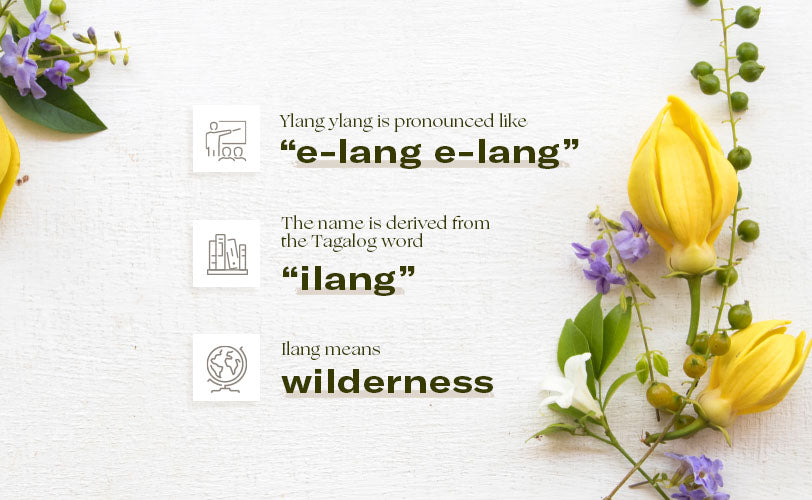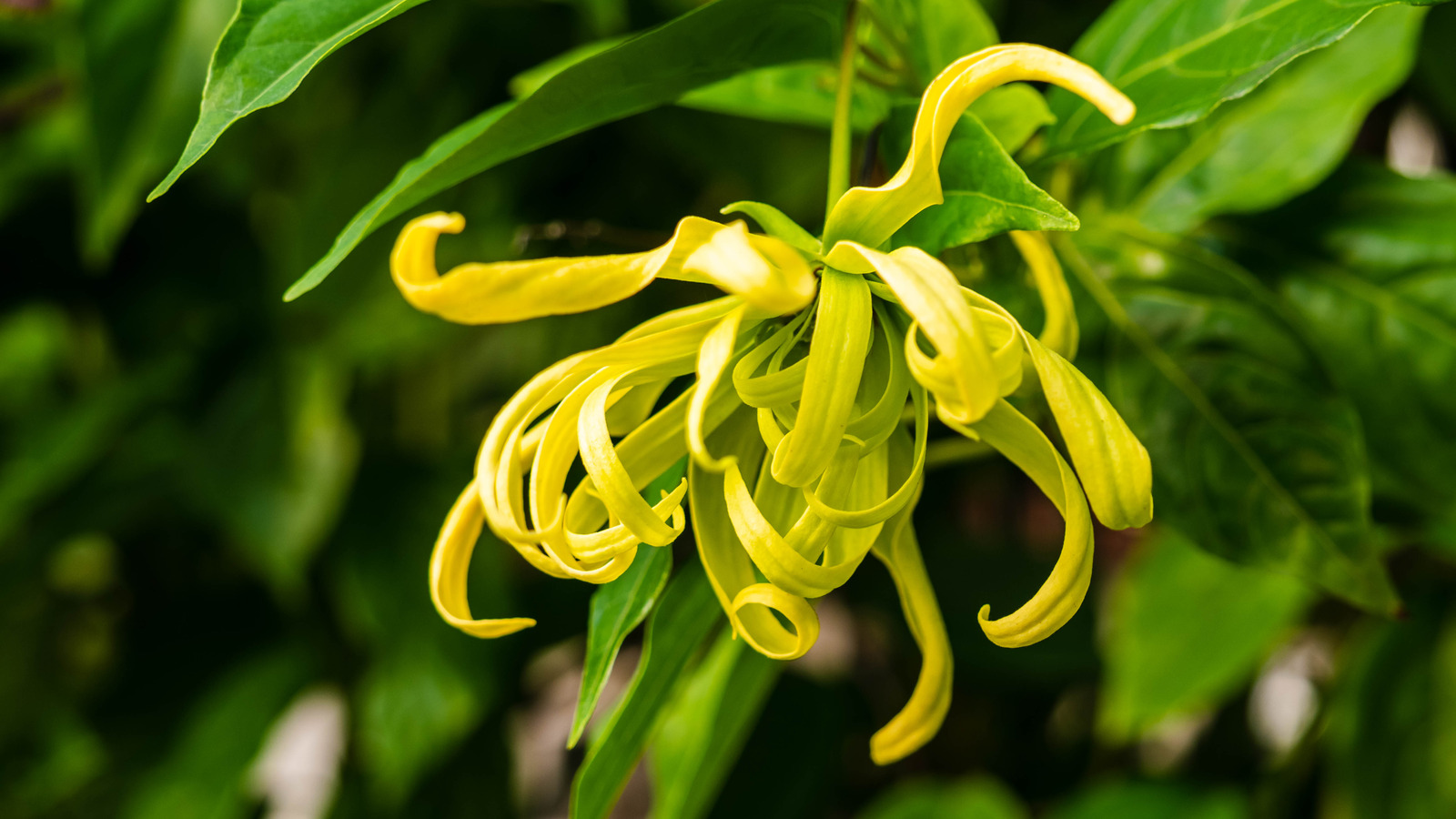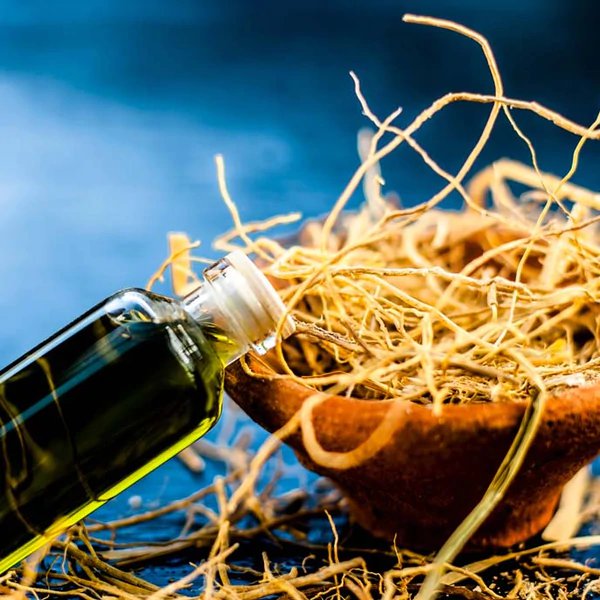Have you ever wondered what ylang ylang smells like? This exotic flower with its captivatingly fragrant star-shaped flowers is widely used in perfumery and aromatherapy. But how exactly would you describe it? Is it sweet, spicy, or something else entirely? We already know about the scents of oud, vetiver, bergamot, and amber, so in this article, we will explore the fragrant world of ylang ylang together, from its floral notes to its surprisingly fruity and even ice cream flavor!

WHAT IS YLANG YLANG?
Ylang ylang is a star-shaped, yellow flower that grows on the canaga tree, also called the “perfume tree.” This tropical tree belongs to the custard apple family and is native to South Asian countries in the Indo-Pacific region.
Scientifically known as Cananga odorata, the tree’s name comes from the Latin word “odoratus,” meaning “fragrant” or “perfumed.” Sometimes, “ylang ylang” is also used to refer to the tree itself.
The cananga tree is an evergreen that can grow up to 40 meters tall. It has drooping branches with dark green leaves and clusters of yellow ylang ylang flowers. These flowers grow in groups of 4-12 on the oldest parts of the branches. Each flower has two sets of three petals, initially green but turning yellow as they mature and eventually brown with a reddish-brown base.
The history of ylang ylang has a couple of theories. Some suggest it spread throughout South Asia when Polynesians resettled anciently, while others think it gained popularity during European colonialism. Regardless, commercial cultivation for its aromatic essential oils began in the 18th century.

WHAT DOES YLANG YLANG SMELL LIKE?
Ylang ylang has a special scent that’s romantic and dreamy. It smells like flowers mixed with creamy, sweet, and slightly spicy banana, jasmine, neroli, and honey. It goes well with other smells and has a unique richness.
One important part of its smell is linalool, a natural alcohol that adds a fresh, floral scent. Ylang ylang is often used in perfumes and products for women, but it can also be used in scents for men, especially when mixed with sandalwood and vetiver.
WHERE DOES YLANG YLANG COME FROM?
To get the essential oil from ylang ylang flowers, they use a method called steam distillation. This process turns the flower’s smell into vapor, which is then collected and condensed.
There are different types of ylang ylang, and depending on what it’s used for, they extract it in different strengths. Perfume needs a stronger concentration compared to things like cosmetics.
The most powerful and pricey version is called “Extra.” It has the most natural compounds like linalool, geranyl acetate, and benzyl acetate. It’s commonly used in fancy perfumes because of its rich smell. There are also “First,” “Second,” and “Third” grades, which vary in strength. “Third” is the mildest.
To make a type called “Complete,” they distill the flowers continuously for 10 to 20 hours. This version has a mix of all the different strengths and contains heavy scents like betacaryophyllene and germacrene, which give fragrances a deep, floral, and fruity smell when mixed with ylang ylang.
BENEFITS OF YLANG YLANG
Ylang ylang, known for its sweet and floral fragrance, boasts a variety of potential benefits. Perhaps the most well-documented is its ability to promote relaxation and combat anxiety. Studies have shown that ylang ylang can lower blood pressure and heart rate, contributing to a calmer state of mind. Additionally, its pleasant scent is believed to have mood-boosting properties, potentially reducing symptoms of depression.
Ylang ylang may also hold benefits for your skin and hair. The oil extracted from the ylang ylang flower contains linalool, a compound with antibacterial and antifungal properties. This can be helpful in promoting healthy circulation and reducing inflammation in the skin. Some also use ylang ylang for hair care, as it may add shine and improve scalp health.
Remember that while research is ongoing, much of the evidence surrounding ylang ylang’s benefits is based on tradition and preliminary studies. If you’re considering using ylang ylang essential oil, it’s important to consult with a healthcare professional first, especially if you have any underlying health conditions. Always dilute the oil before applying it to your skin and perform a patch test to check for allergies.
HOW DO YOU PRONOUNCE “YLANG YLANG”?
Ylang Ylang is pronounced as “e-lang e-lang.” Its name originates from the Tagalog word “ilang,” which means “wilderness,” describing how the flowers sway in the wind. While some suggest that “ylang ylang” translates to “flower of flowers,” experts disagree, considering it a mistranslation. However, given its irresistible scent, one might find the idea quite tempting!
5 BEST YLANG YLANG CANDLE
Hush Candle Ylang Ylang Clove Essential Oil Candle: This candle is made with all-natural soy wax and is scented with therapeutic essential oils. The combination of ylang ylang and clove creates a warm, sensual, and sophisticated scent that is perfect for unwinding after a long day.
LA JOLIE MUSE Gardenia & Ylang Ylang Scented Candle: This candle features a blend of gardenia and ylang ylang for a truly intoxicating fragrance. It also has a long burn time of up to 90 hours, making it a great value for the price.
The Crescent Bloom British Luxury Soy Wax Ylang Ylang Candle: This luxurious candle is made with soy wax and is infused with pure essential oils. It has a beautiful scent that is both floral and uplifting. The candle also comes in a beautiful glass jar with a stainless steel lid, making it a perfect gift.
NEOM Limited Edition Feel Good Vibes Candle (Travel Size) – Ylang Ylang: This travel-sized candle is perfect for taking with you on the go. It has a sweet and floral scent of ylang ylang that is sure to lift your mood.
Phatoil Ylang Ylang Essential Oil (While not exactly a candle, this essential oil can be used in an essential oil diffuser to create a ylang ylang scent) This pure essential oil can be used in a diffuser to create a relaxing and calming atmosphere in your home. It can also be added to carrier oils, such as jojoba oil, for topical use.
FAQ
1. Is ylang ylang good for sleep?
Yes. Similar to lavender oil, ylang ylang has a natural ability to lower blood pressure and heart rate, making it conducive to inducing sleep.
2. What are some words used to describe ylang ylang’s scent?
Floral, sweet, romantic, exotic, fruity, creamy, balsamic, powdery, honeyed, spicy, earthy.
3. Does ylang ylang have any non-floral notes?
Yes, ylang ylang can have subtle earthy, green, or even slightly rubbery undertones.
4. Can I use ylang ylang oil directly on my skin?
No, ylang ylang oil is quite potent and should be diluted with a carrier oil before topical application.
5. Can I grow a ylang ylang tree?
Ylang ylang trees can be grown in warm, humid climates, but they may not flower indoors.
CONCLUSION
In conclusion, ylang ylang boasts a complex and captivating aroma that’s both floral and sweet. With hints of jasmine, neroli, and even fruity or spicy nuances, it offers a truly unique olfactory experience. Whether you encounter it in a perfume, essential oil, or even while traveling to Southeast Asia, ylang ylang’s intoxicating scent is sure to leave a lasting impression.



